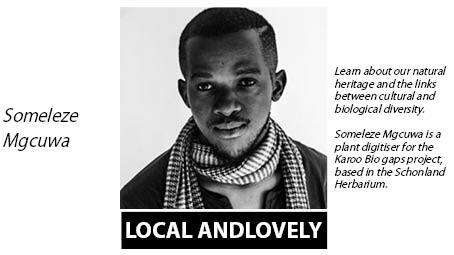
Name: Euphorbia triangularis Desf.
Family: Euphorbiaceae (Spurge family)
Common names:
Engl. Chandelier Tree, River Euphorbia, Tree Euphorbia
Afr. Driehoek-melkbos, Naboom, Noorsdoring, Rivier-naboom,
Xho. Umhlontlo
Description
A spiny, succulent, candelabra-shaped tree up to 18 m in tall. Trunk: cylindrical with traces of four angles, sometimes developing two or more stem-like branches, each bearing a rounded crown of upward-curving branchlets 1,5-2,5m long. Branchlets: usually 3-angled, constricted, forming segments with parallel sides, 7-5-30cm long, yellowish green; margin sinuate, with or without tubercles. Spines: slender, inconspicuous, brown to grey, diverging; spine shields separate, or forming a continuous horny ridge along the margin. Inflorescence: greenish yellow; cythia in 2-3 vertical cymes (June). Fruit: a somewhat rounded, 3-lobed capsule, with a distinct curved stalk (July).
Conservation status
According to the SANBI (South African National Biodiversity Institute) Red list of South African Plants, Euphorbia triangularis was not selected in any one of four screening processes for highlighting potential taxa of conservation concern for detailed assessment and was hence given an automated status of Least Concern (L.C.) http://redlist.sanbi.org
Distribution and habitat
- triangularis is often found in arid country, on rocky hillsides and river valleys, and along tidal rivers, almost reaching the water’s edge. Provincial distribution: Eastern Cape, KwaZulu-Natal and Mpumalanga.
Derivation of name and historical aspects
The common name “spurge” derives from the Middle English/Old French spurge (“to purge”), due to the use of the plant’s sap as a purgative. Euphorbia derives from Euphorbus, the Greek physician of King Juba II of Numidia (52-50 BC -23 AD), who married the daughter of Anthony and Cleopatra. Juba was a prolific writer on various subjects, including natural history. Euphorbus wrote one of the cactus-like euphorbia (now called Euphorbia obtusifolia ssp. regis-jubae) was used as powerful laxative. In 12 BC, Juba named this plant after his physician Euphorbus. In 1753, botanist and taxonomist Carl Linnaeus assigned the name Euphorbia to the entire genus in the physician’s honor. Triangularis means tree angled.
Uses and cultural aspects
A special relationship is believed to exist between the twins and many Euphorbia species, including this one. The Xhosa people in some areas believe that if twins are born, the father must go into the veld and bring back two of these trees and plant them, side by side, in front of the home. The growth of these Euphorbia is supposed to coincide with the growth of the twins. If the twins are of the same size the trees grow an equal height; if one of the twins is short in stature his tree will likewise be stunted in growth. In the same way these indicate the state of health of the twins. If one of trees withers or is in danger of dying, people infer that its owner too is ill; and even if the owner is away from home his relatives will know that he is probably ill. In the event of one twin dying his or her euphorbia tree is removed. It is said that the trees are differentiated at the outset in that the first planted represents the first born twin and the second represents the second twin. When the twins become sick the roots of their specific euphorbia tree are prepared and used as body wash. Should either of the twins die, so would their euphorbia trees. In case of triplets, three euphorbia trees are planted.
In case of relocating, great care is taken to avoid damage to the trees when being located. They should not “bleed (that is, become damaged and release milky sap) for fear of endangering the lives of the twins with whom they are symbolically identified. When collecting the young trees the father of twins places white beads in each of the holes from which the plants were taken, to appease to the ancestors. The afterbirth is buried next to the euphorbia trees and the umbilical cords are plastered on the hut. Soon after the birth the twins are washed in an infusion of the crushed euphorbia roots to ensure their health. Even when they are adults they will travel great distances washed beside their euphorbia trees. If a leaf of one of the trees injured accidentally, two white beads must be placed at the base of the injured tree to ward off evil consequences to one of the twins. Even if the home has been abandoned the trees are left untouched. The custom has been observed for hundreds of years and carries great significance. The same belief is held regarding E. tetragona and E. grandidens.
How to cultivate a Euphorbia plant
As a general rule, Spurge requires well-drained soil in full sun. A few tolerate shadier conditions, but none of the family are fussy about soil conditions. They even thrive in very poor soils and can tolerate periods of drought. Euphorbia plant care is simple. Provide them light, moderate moisture and watch for annoying pests, like whitefly. Provide water under the plant’s leaves to prevent water-soluble plant food. Prune when the plant gets out of control. These plants are almost impossible to kill and are a perfect choice for the novice gardener. Growing euphorbia to share with a friend is also a great beginner propagation project. Read further: https://www.gardeningknowhow.com/ornamental/cacti-succulents/euphorbia/growing-euphorbia-plants.htm for Additional Growing Tips for Euphorbia


